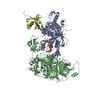+ Open data
Open data
- Basic information
Basic information
| Entry | Database: PDB / ID: 9hnw | |||||||||
|---|---|---|---|---|---|---|---|---|---|---|
| Title | USP1-UAF1 bound to Lys63-linked diubiquitin | |||||||||
 Components Components |
| |||||||||
 Keywords Keywords | HYDROLASE / USP1 / deubiquitinating enzyme / cysteine protease / complex | |||||||||
| Function / homology |  Function and homology information Function and homology informationregulation of protein monoubiquitination / positive regulation of error-prone translesion synthesis / Signaling by cytosolic PDGFRA and PDGFRB fusion proteins / monoubiquitinated protein deubiquitination / seminiferous tubule development / deubiquitinase activator activity / symbiont entry into host cell via disruption of host cell glycocalyx / skeletal system morphogenesis / skin development / symbiont entry into host cell via disruption of host cell envelope ...regulation of protein monoubiquitination / positive regulation of error-prone translesion synthesis / Signaling by cytosolic PDGFRA and PDGFRB fusion proteins / monoubiquitinated protein deubiquitination / seminiferous tubule development / deubiquitinase activator activity / symbiont entry into host cell via disruption of host cell glycocalyx / skeletal system morphogenesis / skin development / symbiont entry into host cell via disruption of host cell envelope / virus tail / homeostasis of number of cells / protein deubiquitination / embryonic organ development / single fertilization / positive regulation of double-strand break repair via homologous recombination / regulation of DNA repair / response to UV / Fanconi Anemia Pathway / ubiquitin binding / Recognition of DNA damage by PCNA-containing replication complex / positive regulation of epithelial cell proliferation / skeletal system development / double-strand break repair via homologous recombination / positive regulation of receptor signaling pathway via JAK-STAT / regulation of protein stability / multicellular organism growth / late endosome / peptidase activity / single-stranded DNA binding / double-stranded DNA binding / spermatogenesis / ubiquitinyl hydrolase 1 / cysteine-type deubiquitinase activity / lysosome / Ub-specific processing proteases / cysteine-type endopeptidase activity / DNA repair / intracellular membrane-bounded organelle / DNA damage response / proteolysis / DNA binding / nucleoplasm / nucleus / cytosol / cytoplasm Similarity search - Function | |||||||||
| Biological species |  Homo sapiens (human) Homo sapiens (human) | |||||||||
| Method | ELECTRON MICROSCOPY / single particle reconstruction / cryo EM / Resolution: 3.04 Å | |||||||||
 Authors Authors | Keijzer, N. / Sakoltchik, J. / Sixma, T.K. | |||||||||
| Funding support |  Netherlands, 2items Netherlands, 2items
| |||||||||
 Citation Citation |  Journal: To Be Published Journal: To Be PublishedTitle: USP1-UAF1 bound to Lys63-linked diubiquitin Authors: Keijzer, N. / Sixma, T.K. / Sakoltchik, J. | |||||||||
| History |
|
- Structure visualization
Structure visualization
| Structure viewer | Molecule:  Molmil Molmil Jmol/JSmol Jmol/JSmol |
|---|
- Downloads & links
Downloads & links
- Download
Download
| PDBx/mmCIF format |  9hnw.cif.gz 9hnw.cif.gz | 231.3 KB | Display |  PDBx/mmCIF format PDBx/mmCIF format |
|---|---|---|---|---|
| PDB format |  pdb9hnw.ent.gz pdb9hnw.ent.gz | 175.3 KB | Display |  PDB format PDB format |
| PDBx/mmJSON format |  9hnw.json.gz 9hnw.json.gz | Tree view |  PDBx/mmJSON format PDBx/mmJSON format | |
| Others |  Other downloads Other downloads |
-Validation report
| Summary document |  9hnw_validation.pdf.gz 9hnw_validation.pdf.gz | 1.2 MB | Display |  wwPDB validaton report wwPDB validaton report |
|---|---|---|---|---|
| Full document |  9hnw_full_validation.pdf.gz 9hnw_full_validation.pdf.gz | 1.2 MB | Display | |
| Data in XML |  9hnw_validation.xml.gz 9hnw_validation.xml.gz | 49.8 KB | Display | |
| Data in CIF |  9hnw_validation.cif.gz 9hnw_validation.cif.gz | 74.3 KB | Display | |
| Arichive directory |  https://data.pdbj.org/pub/pdb/validation_reports/hn/9hnw https://data.pdbj.org/pub/pdb/validation_reports/hn/9hnw ftp://data.pdbj.org/pub/pdb/validation_reports/hn/9hnw ftp://data.pdbj.org/pub/pdb/validation_reports/hn/9hnw | HTTPS FTP |
-Related structure data
| Related structure data |  52316MC M: map data used to model this data C: citing same article ( |
|---|---|
| Similar structure data | Similarity search - Function & homology  F&H Search F&H Search |
- Links
Links
- Assembly
Assembly
| Deposited unit | 
|
|---|---|
| 1 |
|
- Components
Components
| #1: Protein | Mass: 91785.992 Da / Num. of mol.: 1 / Mutation: G670A, G671A Source method: isolated from a genetically manipulated source Source: (gene. exp.)  Homo sapiens (human) / Gene: USP1 / Production host: Homo sapiens (human) / Gene: USP1 / Production host:  |
|---|---|
| #2: Protein | Mass: 80130.719 Da / Num. of mol.: 1 Source method: isolated from a genetically manipulated source Source: (gene. exp.)  Homo sapiens (human) / Gene: WDR48, KIAA1449, UAF1 / Production host: Homo sapiens (human) / Gene: WDR48, KIAA1449, UAF1 / Production host:  |
| #3: Protein | Mass: 8604.884 Da / Num. of mol.: 1 / Source method: obtained synthetically / Source: (synth.)  Homo sapiens (human) / References: UniProt: P0CG47 Homo sapiens (human) / References: UniProt: P0CG47 |
| #4: Protein | Mass: 8547.770 Da / Num. of mol.: 1 / Mutation: K63(DAB) / Source method: obtained synthetically / Source: (synth.)  Homo sapiens (human) / References: UniProt: P0CG47 Homo sapiens (human) / References: UniProt: P0CG47 |
| #5: Chemical | ChemComp-ZN / |
| Has ligand of interest | N |
| Has protein modification | Y |
-Experimental details
-Experiment
| Experiment | Method: ELECTRON MICROSCOPY |
|---|---|
| EM experiment | Aggregation state: PARTICLE / 3D reconstruction method: single particle reconstruction |
- Sample preparation
Sample preparation
| Component | Name: USP1-UAF1 bound to Lys63-linked diubiquitin / Type: COMPLEX / Entity ID: #1-#2, #4 / Source: RECOMBINANT | ||||||||||||||||||||
|---|---|---|---|---|---|---|---|---|---|---|---|---|---|---|---|---|---|---|---|---|---|
| Molecular weight | Experimental value: NO | ||||||||||||||||||||
| Source (natural) | Organism:  Homo sapiens (human) Homo sapiens (human) | ||||||||||||||||||||
| Source (recombinant) | Organism:  | ||||||||||||||||||||
| Buffer solution | pH: 7.5 | ||||||||||||||||||||
| Buffer component |
| ||||||||||||||||||||
| Specimen | Conc.: 0.75 mg/ml / Embedding applied: NO / Shadowing applied: NO / Staining applied: NO / Vitrification applied: YES | ||||||||||||||||||||
| Specimen support | Grid material: COPPER / Grid mesh size: 300 divisions/in. / Grid type: Quantifoil R1.2/1.3 | ||||||||||||||||||||
| Vitrification | Instrument: FEI VITROBOT MARK IV / Cryogen name: ETHANE / Humidity: 100 % / Chamber temperature: 277.15 K |
- Electron microscopy imaging
Electron microscopy imaging
| Experimental equipment |  Model: Titan Krios / Image courtesy: FEI Company |
|---|---|
| Microscopy | Model: TFS KRIOS Details: Collected on Krios 1 at Netherlands Center for Electron Nanoscopy (NeCEN) |
| Electron gun | Electron source:  FIELD EMISSION GUN / Accelerating voltage: 300 kV / Illumination mode: FLOOD BEAM FIELD EMISSION GUN / Accelerating voltage: 300 kV / Illumination mode: FLOOD BEAM |
| Electron lens | Mode: BRIGHT FIELD / Nominal magnification: 10500 X / Nominal defocus max: 2400 nm / Nominal defocus min: 1200 nm / Cs: 2.7 mm / C2 aperture diameter: 50 µm / Alignment procedure: COMA FREE |
| Specimen holder | Cryogen: NITROGEN / Specimen holder model: FEI TITAN KRIOS AUTOGRID HOLDER |
| Image recording | Average exposure time: 2.71 sec. / Electron dose: 50 e/Å2 / Film or detector model: GATAN K3 BIOQUANTUM (6k x 4k) / Num. of grids imaged: 1 / Num. of real images: 5833 |
- Processing
Processing
| EM software |
| ||||||
|---|---|---|---|---|---|---|---|
| CTF correction | Type: PHASE FLIPPING AND AMPLITUDE CORRECTION | ||||||
| Particle selection | Num. of particles selected: 3110350 | ||||||
| 3D reconstruction | Resolution: 3.04 Å / Resolution method: FSC 0.143 CUT-OFF / Num. of particles: 299304 / Algorithm: FOURIER SPACE / Symmetry type: POINT | ||||||
| Refinement | Highest resolution: 3.04 Å |
 Movie
Movie Controller
Controller



 PDBj
PDBj




